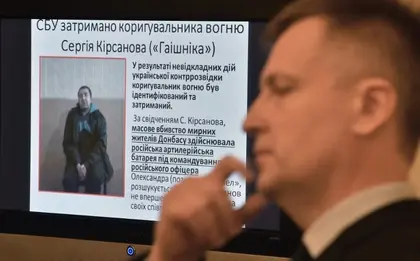SBU chief Valentyn Nalyvaichenko showed at a press conference the video interrogation of Mariupol resident Valery Kirsanov, who said he was giving the coordinates of a Ukrainian checkpoint in Mariupol to a Russian officer with the nickname of “Pepel.”
Kirsanov said that he was an agent of Russian mercenaries and, as a former traffic police officer, he knew the location of the Ukrainian military in the Azov Sea port city of 500,000 people. The strategic Donetsk Oblast city is under the control of the Ukrainian government but under threat of attack by Russia, which many suspect is seeking a land bridge in southern Ukraine to connect Russia to Russia-annexed Crimea.
JOIN US ON TELEGRAM
Follow our coverage of the war on the @Kyivpost_official.
With the help of Google Earth, Kirsanov identified the exact coordinates of the military positions and sent them by text messages to “Pepel,” who conducted the attacks.
“Pepel is an officer of the Russian army and he leads an artillery battalion,” Kirsanov said.
Kirsanov claimed the devastating shelling attacks in Mariupol on Jan. 24 were planned to be done overnight but it happened in the morning at about 8 a.m. “I went to see what happened and told Pepel that they missed by one kilometer,” Kirsanov said. “I said that very many people died.”
Kirsanov gives testimony to SBU.
The SBU also published on their website an intercepted conversation between Kirsanov and Pepel, where Kirsanov addressed him by the name Aleksandr and said that he “has greatly overdone.”
Intercepted phone conversation between Kirsanov and Pepel.
Nalyvaichenko also showed photos of remnants of shells found in Mariupol, claiming that they are what is left of Grads and Tulip multiple rocket launchers “delivered by Russian servicemen from Russian military bases of the Southern Military District.”
Nalyvaichenko added that part of these rocket launchers was destroyed by Ukrainian army, while another part of them was hidden in the city of Markine and then brought to Russian territory. The SBU said that the Russians stopped shelling and started hiding their Grads and Tulips at 2 pm after receiving the information that OSCE monitors were heading to the place of the attack.
On Jan. 26, two days after the devastating attack, residents of the eastern quarter of Mariupol were burying the victims of shelling and repairing their destroyed dwellings. The volunteers were checking the houses to find out about the victims and needs of residents. There were big lines for plastic film needed to cover the smashed windows. In many apartment buildings there were indications on the walls “Everyone is alive here” written by residents to facilitate the work of volunteers and social workers.
Ukraine’s authorities have continuously accused Russia of open involvement in the eastern war and terrorist activity on the country’s territory. President Petro Poroshenko claimed last week that 9,000 Russian troops were currently present in Ukraine.
Russia always denied these claims, demanding to show some proofs. “Nobody can show us proofs, or they don’t want to,” Russian Foreign Minister Sergei Lavrov said at his latest press conference, commenting on the accusation of sending weapons and servicemen to Ukrainian territory.
More reports about Russian presence started piling up over the last week.
On Jan. 25 the press office of the anti-terrorist operation’s headquarters reported that insurgents and Russian troops’ offensive towards Popasna in the Luhansk Oblast is led by Major General Sergei Kuzovlev, chief of staff at the 58th Army of Russia’s Southern Military District.
Alexander Peredruk, a spokesman for the St. Petersburg Committee of Soldiers’ Mothers, said on Jan. 23 that about 80 conscripts had been forced to sign professional contracts with the military. He said that they could be sent to Ukraine. Russian news agency Novy Region reported then, citing anonymous sources, that the conscripts would fight in Donbas as part of the 138th Motorized Brigade.
Nalyvaichenko claimed that SBU managed to detain 41 Russian nationals. He showed photos of Russian citizen Mykola Korchagin, who was sentenced to eight years in prison by a court in Sloviansk in Donetsk Oblast on Jan. 13 for terrorist activity in the self-proclaimed Donetsk People’s Republic.
The SBU also showed photos of documents and of the dead body of one more Russian national, Andrey Yemelianov, who was a member of a separatist Cossack unit. He was killed in fighting against the Ukrainian army on Jan. 23. Nalyvaichenko said the Ukrainian side wanted to give over Yemelianov’s body to his relatives or Russian officials.
Nalyvaichenko called on Russian Ambassador to Ukraine Mikhail Zurabov to come and receive the evidence about Russian involvement in the war against Ukraine. “Our gestures have both an evidentiary and human aim,” he said.
Kyiv Post photo journalist Anastasia Vlasova contributed reporting to the story from Mariupol.
Kyiv Post staff writers Oksana Grytsenko and Oleg Sukhov can be reached at grytsenko@kyivpost.com andsukhov@kyivpost.com
You can also highlight the text and press Ctrl + Enter




